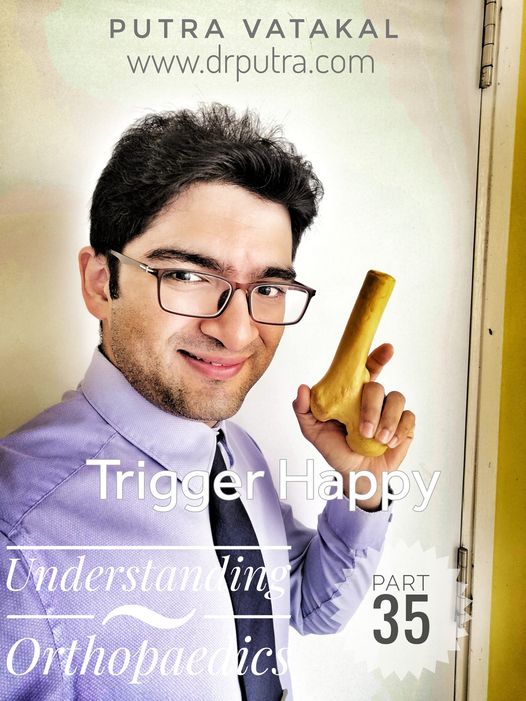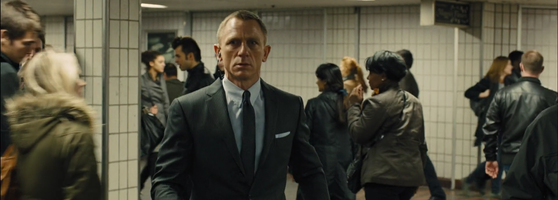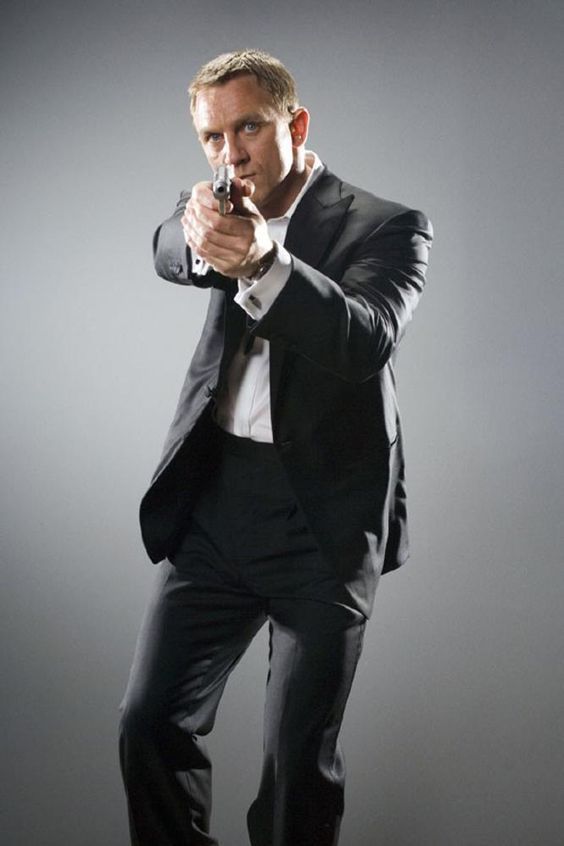
CHAPTER 1
(To skip the story and just learn about Trigger Finger, go straight to Chapter 2)
Warm air hisses through the painted vents as the LRT train slides out of the station. The crowd mobs the turnstiles toward the exit…among them a bald man mopping sweat off his neck, glancing back across the crowd as he hurried up the narrow stairs.
On a steel bench across the tracks, Mr. Bond sits, eyes closed, arms crossed across his chest, gently rocking to the clank-clank of the train on its tracks.
Eyes barely open, but silently watching the moving crowd.
The bald man’s handkerchief slides across his neck, drawing Bond’s eye to a dark tattoo at the base of his neck.
Ding! The bell rings announcing the arrival of the next train. Bond springs from the bench and onto the tracks. Pistol in hand, he leaps across the barriers, and tears through the roaring crowd.

An old lady screams as the stone-faced stranger rushes by her. Several others, catching sight of the gun, push into their neighbours, slowly sending the crowd to the floor.
But not the bald man. He keeps hurrying up the stairs.

Eyes fixed on the fleeing bald head, Bond raises his pistol and squeezes the trigger.
Bang! Shouts ring out across the station. The bald SPECTRE agent turns on the landing to see Bond bent over, clutching his right hand in his left, face twisted in pain. He sees the gun fallen on the floor, and runs out of the station, escaping into the anonymous KL Sentral crowds.
A man in long sleeves and a blue tie walks over and grasps Bond’s shoulder.
“Mr. Bond?” he asks.
Bond nods painfully. “He got away… my hand…”, says Bond.
“The name is Putra. Putra Vatakal. I’m an orthopaedic surgeon. You seem to be having Trigger Finger. Let me look at your hand. ” he says.
CHAPTER 2
Alright, perhaps most attacks of ‘Trigger Finger’ aren’t quite THAT dramatic. And most people with Trigger Finger have never seen a real gun.
But the pain and disability they suffer are definitely real.
Question: What exactly is TRIGGER FINGER?
Unknown to Mr James Bond, the medical term for it is Stenosing Tenosynovitis– which is a complicated way to say the tissue around your finger tendon is swollen till the movement of the tendon is blocked.
Curl your fingers into a fist now, if you can. The source of the problem is usually right where your fingertips meet your palm.
Right there, under the skin and tissue layers lies a ‘tunnel’ called the A1 Pulley. We can bend our fingers because the tendon responsible to bend that finger passes smoothly through this ‘tunnel’ (the A1 Pulley)… rather like a train running on tracks through a tunnel.
If something happens that blocks the train (the tendon) from going through the tunnel, our finger movements become painfully jammed… which is what we call Trigger Finger.
Question: How will I know if I have Trigger Finger?
Oh, you’ll usually know.
Trigger Finger happens gradually, starting with mild pain when you bend and straighten the joints of your finger (we call this Grade 1). Statistically, it’s usually the ring or middle finger, but any finger can be involved, including the thumb.
As time creeps along, and the tunnel gets tighter. Bending your finger is usually okay, but you start to feel a ‘click’ when you straighten it. Some people find this painful, but for others, it’s bearable (we call this Grade 2).
Grade 3 is when the ‘tunnel’ is so narrow that straightening your finger becomes a problem, and you will probably need to use your other hand to ‘help’ your ‘stuck’ finger to get straight again. At this stage, many people need surgery to get back to normal.
If the problem is left untreated, then we get to Grade 4 – where the finger is stuck in one position and can’t move at all.
Thankfully, most people get treatment well before it gets this bad.
Question: Do all Trigger Fingers need an operation?
No.
Earlier on in the problem, some anti-inflammatory medicines, stretching exercises etc will usually reverse Trigger Finger. So, in most cases, we start with exercises and see how your finger responds.
If exercise alone doesn’t do the trick, sometimes injections (of steroids mixed with a local anesthetic) can help ease the pain and improve finger movements.
Of course, surgery is an option, and as Trigger Finger progresses, it can become the treatment of choice. The operation for trigger finger is usually done with you awake (which sounds scarier than it really is). After giving you some local anesthetic to numb a part of your hand, a small cut is made along one of the creases on your palm.
What I look for is the thickened roof of the tunnel (where the tendon ‘train’ runs, remember?). It usually takes a small snip of the thickened tissue (the A1 Pulley), and the shiny white tendon is ready to glide beautifully again.
Most people can go back home immediately after surgery, though sometimes you might need to come back to get a stitch or two removed about 2 weeks later.
One thing I tell my patients is that even after an operation, it’s SUPER important to keep doing finger movement exercises to ensure their finger doesn’t start triggering again!
CHAPTER 3
Two weeks later, a pain free Mr. Bond is having Roti Canai and some Chee Cheong Fun at a stall in Petaling Jaya (in our fictional COVID-less world) when he spots a familiar face at the Nasi Lemak stall. It’s the bald guy from SPECTRE!
Licking dhall curry off his lips, he pulls out his pistol and aims at the bald man’s chest.
“Just a minute, Mr Bond.” says the man across the table.

“Is violence the answer to all the world’s problems?” Dr Putra sips his Teh-O kosong and waves’s Bond’s gun back to the table.
“Well, I guess not,” says Bond.
“I’ll call him over for some Teh Tarik”.
And this is where the credits roll.
Originally written on 3 Feb 2021 in Quill Orthopaedic Specialist Centre, TTDI, Kuala Lumpur
Note: Names and some details have been changed to protect national secrets, and patient privacy.